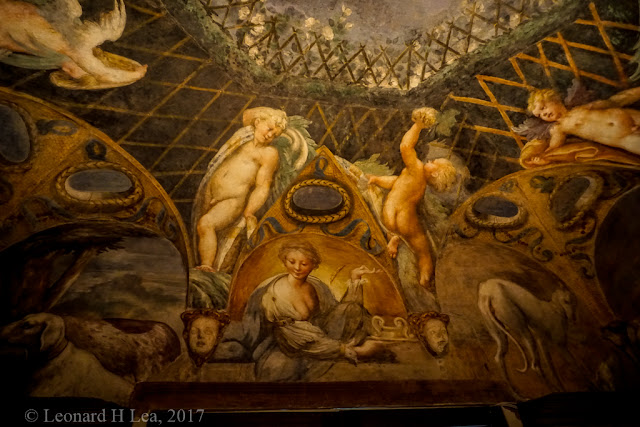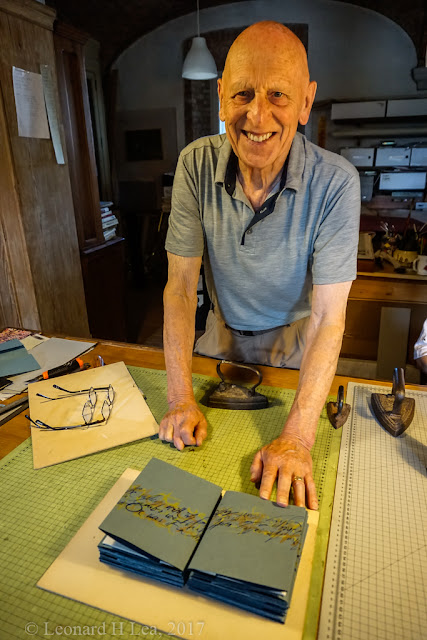We visited the town of Fontanellato several times, the first time in the evening and saw the moated castle nicely lit with few people around.
This castle is known as Rocca Sanvitale and was begun in the 13th century and finished in the 15th century, which is when the town began to grow around it. Until the middle of the 20th century it remained the home of the descendants of the Count of Sanvitale. We visited the castle a second time and were able to visit the interior rooms with wonderful fresco's. We were accompanied by Andre who has a great deal of knowledge of the fresco origins.
This is part of the fresco known as Diane and Acteon, painted by Francesco Mazzola, commonly known as Parmigianino ("the little one from Parma"), in 1523-34. When he painted this fresco he was only 20 years old, which underscores his amazing talent.
This is the room you see before the Diane and Acteon, fresco, and indicates the dramatic difference displayed in the style of painting.
We went to the Sunday market in Fontanellato and enjoyed the many local offerings. I thought this photograph epitomized the region with Parmesan cheese and one of the many forms of Parma ham.
We also took a trip to Castell'Arquato, which is in the foothills about 10 miles or so from Toccalmatto. This castle sits in a commanding position overlooking the valley below. It is believed to have originated in Roman times as a military settlement. The first recorded news of this castle occurred about the middle of the 8th century.
It was quite a walk up to the castle entrance,
but it began with this lovely tree-lined avenue.
There was so much to see, but I thought this photograph gave some idea of the commanding position of the castle.
This is the Collegiata di Santa Maria, the church also built on the site in the middle of the 8th century. It was, however, rebuilt after the earthquake of 1117, so I guess it counts as a "new" church in this part of the world!
There is a small restaurant next to the arch under the clock tower. We took the opportunity to relax for a while with an aperitivo.
The next evening, Carla took us to another castle, in the town of Vigoleno.
The good news for this visit was that we could drive to the castle entrance!
The town of Vigoleno is largely within the castle walls. All the streets were cobbled, some offering glimpses of the countryside below.
Walking down the streets also meant that we had to walk up. The benefit of visiting in the evening was that is was cool with the occasional breeze.
We passed by several Trattoria. Each looked very inviting and interesting. Notice the ATV, an easy way to maneuver some of the steep narrow streets.
The photo above is in the castle main square. It was interesting to see that there was a large cistern, reminding us that this castle was first built in the 10th century which required a secure supply of water to withstand any possible siege. You can stay in the castle, as it is run as a small hotel.
Next was a visit to the Abbey of Clairvaux of the Dove, or Abbazia di Chiaravalle della Colomba in Italian, which sounds more colorful. We were fortunate to be here at this time of year, as this is when the "Flower Festival of Corpus Domini" occurs.
This is a beautiful carpet of flowers set in place along the central aisle of the basilica.
Close-ups of some of the details of construction. Fortunately all of the flower petals and other elements of the display were still fairly fresh. This is a Cistercian Abbey that is well preserved and still has practicing monks in residence.
This is a statement from the Abbey website that describes the layout of the square above, "The architectural complex is built in the traditional Benedictine plan, taken up by the Cistercians, with the fundamental buildings arranged around the square cloister and church".
The inner ring of the cloister is remarkable in it's detail and quite beautiful.
The pillars that make up the cloister walk were difficult to capture in a photograph, but I did attempt to capture these corner columns, all carved from a single piece of marble.
Kathleen taking a walk around the external cloister path.
One last photograph from a room off the cloister walk, dedicated to displays of measurement methods employed in the construction of the Abbey, which were quite fascinating.
We also went for a guided tour of Rocca di Soranga, a castle-palace located in the nearby town of Soranga. This castle was once owned by the princes of the Meli Lupi family and is still inhabited by descendants of that family. Because it is still a family home, no photographs were allowed in the interior rooms. The exterior of the palace is rather plain which belies the beautiful artwork and furnishings within.
The first thing that you notice as you enter the castle courtyard is the Porsche, one of the prince's cars.
The courtyard portico with fresco's depicting vine leaves.
The tour guides spoke only Italian, so we were doubly fortunate that Andre came with us and provided a narrative in English of all that we saw, (again, he is very knowledgeable about all of the art and the history of this castle).
An interesting patio overlooking the castle gardens.
The garden view from the patio.
This post wraps up our visit to France and Italy this summer. I must add our gratitude and appreciation to Andre and Carla for being our knowledgeable guides to these castles and monasteries. I apologize if my memory of some facts is not totally accurate. ( I would also like to thank Wikipedia for providing the occasional extra detail.)
Until next time, thank you for joining us on our travels, au revoir and arrivederci.































































